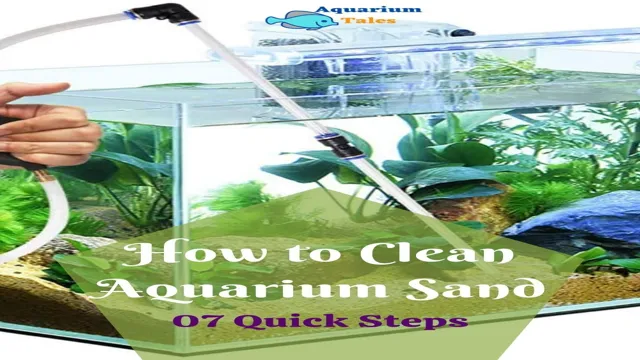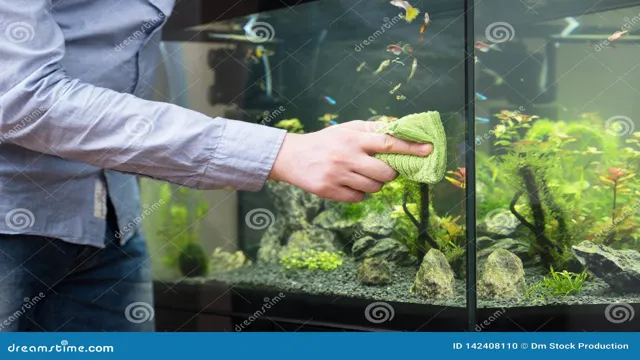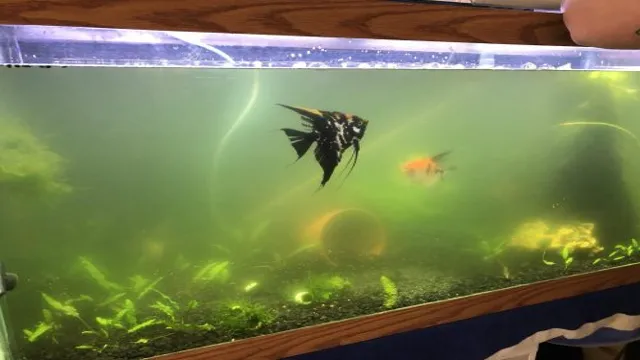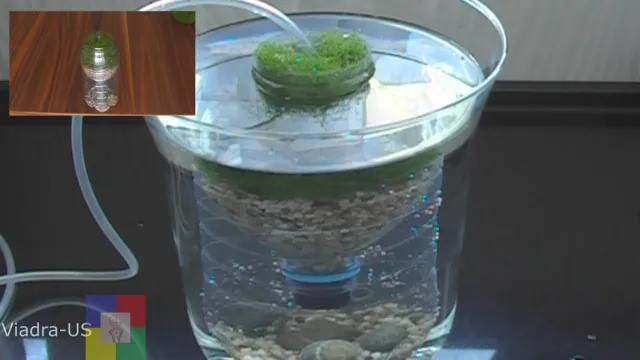Keeping your aquarium clean is essential in maintaining a healthy and vibrant aquatic environment for your fish and plants. However, with so many surfaces to clean, it can be challenging to know where to start. The surface of the aquarium is the first thing people see, and it’s also the most visible part of your tank.
Therefore, keeping it clean and free of algae, debris, and grime is crucial. In this blog post, we’ll guide you through the step-by-step process of how to clean your aquarium surface to keep it gleaming and looking pristine. Don’t worry; it’s not as hard as you might think.
So, grab your cleaning gloves, and let’s begin!
Gather Necessary Cleaning Tools
When it comes to keeping your aquarium clean, the surface plays a crucial role in maintaining its overall health and appearance. The first step is to gather the necessary cleaning tools, which should include a glass cleaner, algae scraper, and a microfiber cleaning cloth. It’s essential to avoid using abrasive materials that can damage the surface of your aquarium and harm your aquatic plants and animals.
Before starting the cleaning process, ensure that you unplug any electrical equipment and remove any large objects in the tank. Next, use the glass cleaner to clean the interior and exterior surfaces of the glass or acrylic tank. The algae scraper is used to remove any algae build-up, while the microfiber cleaning cloth helps to remove debris and polish the surface.
Cleaning your aquarium surface not only enhances the appearance of your tank but also promotes the well-being of your aquatic pets. By maintaining clean and healthy water conditions, your fish, plants, and other aquarium inhabitants will thrive.
– Scraper
When it comes to scraping away dirt and grime from various surfaces, having the right tools is crucial. One such tool that can come in handy is a scraper. Scrapers are typically versatile and can be used on a variety of different surfaces, including glass, tiles, and even paint.
They’re often made from sturdy materials like stainless steel or hard plastic, and they come in various sizes and shapes to suit different needs. Investing in a good quality scraper can make cleaning much more efficient and effective, allowing you to easily remove stubborn dirt and stains from surfaces without resorting to harsh chemicals or excessive scrubbing. So whether you’re cleaning your windows, tiles, or other surfaces around the house or workplace, a scraper is a tool that you’ll definitely want to have on your cleaning kit.

– Sponge
When it comes to cleaning with a sponge, it’s essential to have all the necessary tools at hand. First of all, you’ll need the right type of sponge to get the job done effectively. There are many varieties of sponges out there, each intended for different purposes, so make sure you choose the right one for your cleaning task.
It’s also a good idea to have a bucket of clean water ready to rinse your sponge as needed during the cleaning process. Additionally, you might want to consider some cleaning agents such as an all-purpose cleaner or a disinfectant spray to help loosen dirt and grime. Other useful tools include rubber gloves to protect your hands from harsh chemicals and a scrub brush for those tougher stains.
By gathering all the necessary cleaning tools before starting, you’ll save time and make your cleaning job much more efficient. Remember: having the right tools for the job is essential!
– Cleaning Solution
When it comes to cleaning your home, having the right tools is essential to get the job done efficiently. Before tackling your cleaning tasks, gather the necessary cleaning tools to ensure that you have everything you need on hand. This includes things like a broom and dustpan for sweeping up debris, a vacuum cleaner for carpets and upholstery, and microfiber cloths for dusting surfaces.
Additionally, you’ll need a cleaning solution to tackle tough grime and stains. Choosing the right cleaning solution for your needs is key, as different types work better on different surfaces. For example, an all-purpose cleaner may work well on countertops, but you’ll need a specialized cleaner for tough bathroom grime.
By having all the necessary tools and cleaning solutions ready to go, you’ll be able to clean your home quickly and effectively, leaving it looking spotless in no time.
Empty and Prepare Aquarium
If you want to keep your fish in a healthy environment, it’s essential to know how to clean the aquarium surface properly. Emptying and preparing your aquarium is the first step in cleaning the surface. Before you start, it’s essential to unplug all electrical equipment and remove any decoration, gravel, or plants.
Carefully scoop the fish, using a net, and place them in a temporary tank filled with water from their original aquarium. Afterward, you can then drain the aquarium by siphoning out the water. Once your aquarium is empty, you can remove any debris and scrub away any algae or dirt that has accumulated on the surface.
It’s crucial to use a cleaning solution that’s safe for your fish and work with a soft brush to avoid scratching the glass surface. Rinse the aquarium thoroughly before refilling it with water. By taking the time to empty and prepare your aquarium, you’re ensuring that the surface is clean, safe, and ready for your fish to thrive.
– Remove Fish and Plants
When it’s time to empty and prepare an aquarium, the first step is to remove all fish and plants. This might seem like a daunting task, especially if you have a large aquarium with many fish and plants, but it’s necessary to ensure that the cleaning process is as thorough as possible. Start by catching all of the fish and placing them in a temporary container filled with aquarium water.
You should also remove any plants and decorations that are in the tank. Once everything is out of the tank, it’s time to start cleaning. Use a gravel vacuum to remove any debris from the substrate, then give the glass a good scrub with an aquarium-safe cleaner. (See Also: How to Make a False Bottom for Aquarium: Step-by-Step Guide for Beginners)
Finally, rinse everything thoroughly with clean water to remove any remaining debris or cleaning solution. By removing everything from the tank before cleaning, you’ll be able to give it a deep clean and make sure that it’s ready for your fish and plants to return. Remember, proper cleaning is essential for the health and well-being of your aquatic pets and a long-term happiness of aquarium in general.
– Drain Water
One important step in maintaining a healthy and clean aquarium is to drain and replace the water periodically. To start, you’ll want to gather the necessary equipment such as a siphon or hose, a bucket or container, and a water treatment solution. Next, turn off any electrical components such as heaters or filters and unplug them before removing the water.
Begin by using the siphon or hose to remove about 25-30% of the water from the aquarium. Be sure to vacuum any debris or waste from the substrate during this process. Once the old water has been removed, use a clean bucket or container to prepare the new water.
Add the appropriate amount of water treatment solution and allow it to dissolve before pouring into the aquarium. Once the new water has been added, turn the electrical components back on and allow the water to settle for a few hours. By routinely draining and replacing the water in your aquarium, you can help maintain a healthy environment for your fish and plants to thrive.
– Wipe Interior Surfaces
When it comes to preparing your aquarium for new inhabitants, it’s essential to start with a clean slate. To do this, you’ll want to begin by wiping down all interior surfaces, including the glass or acrylic walls, the substrate, and any decorations or accessories. Doing so will remove any lingering dirt, debris, or algae that might be present, helping to create a more hospitable environment for your aquatic pets.
Depending on the size of your tank, this process may take some time, so be sure to set aside enough time to complete the task thoroughly. Once everything is wiped down, you can begin to prepare the aquarium for its new occupants, making sure to add any necessary equipment, substrate, and decorations before adding water and introducing your fish or other animals. By taking the time to properly clean and prepare your aquarium, you can help ensure a happy and healthy home for your aquatic pets for years to come.
Clean Aquarium Surface
Keeping the aquarium surface clean is essential for the health and well-being of your fish. Not only does it make the aquarium look better, but it also reduces the risk of harmful bacteria being present. To clean the aquarium surface, start by turning off the filter and pump to avoid any disruptions in the water flow.
Using a fish-safe scraper, gently remove any debris or algae from the surface of the glass or acrylic walls. Be careful not to use too much pressure, which could scratch the surface. Once the surface is clean, turn the filter and pump back on, and dispose of the debris in the trash.
Regularly cleaning the aquarium surface not only improves the look of your aquarium but also ensures a healthy and safe environment for your aquatic pets to thrive. So, to keep your fish happy and healthy, make sure to add surface cleaning to your aquarium maintenance routine.
– Scrape off Algae Buildup
When it comes to maintaining a healthy and clean aquarium, one of the most important tasks is scraping off algae buildup from the surface. Algae can quickly take over your aquarium, leaving it looking unsightly and potentially harming the fish and other aquatic creatures living inside. Regular cleaning of the aquarium surface not only helps to keep your tank looking spotless but also serves as a preventative measure against any potential health issues for your fish.
Use a scraper or a cloth to remove any visible algae from the surface, making sure to avoid any delicate decorations or plants. By taking the time to remove algae buildup regularly, you’ll keep your aquarium healthy, happy and looking great.
– Use Sponge and Cleaning Solution
“clean aquarium surface” Keeping an aquarium clean is essential for the health and well-being of the fish and plants living inside. One of the most important tasks of aquarium maintenance is cleaning the surface of the tank. For this purpose, you can use a sponge and a cleaning solution intended for aquariums.
It’s crucial to opt for a non-toxic and safe solution that won’t harm the aquatic creatures. When choosing a sponge, make sure it’s not abrasive to avoid scratching the glass or acrylic walls of the aquarium. Gently scrub the surface of the tank, removing any algae or debris that may have accumulated.
Be sure to rinse and clean the sponge often, as excess debris may scratch the surface of the tank. It’s recommended to clean the surface of the aquarium once a week to prevent buildup and maintain a healthy environment for your aquatic pets. By regularly cleaning the surface of your tank, you can keep your aquarium looking beautiful and ensure the health and well-being of all the inhabitants.
– Rinse with Water and Dry
Cleaning the surface of your aquarium is essential for maintaining a clean and healthy environment for your aquatic friends. After removing any debris or algae buildup, it’s important to rinse the surface thoroughly with clean water. This helps to remove any leftover cleaning solution, which can be harmful to your fish or plants if left on the surface.
Using a clean cloth or paper towel, dry the surface to prevent water spots and streaks. It’s best to avoid using harsh cleaners or abrasive materials, as this can damage the surface and harm your aquatic inhabitants. Additionally, it’s important to perform regular water changes and maintain proper filtration to keep your aquarium in top condition.
By following these simple steps, you can maintain a beautiful and healthy aquatic environment for your fish and plants. (See Also: How to Germinate Dwarf Baby Tears Aquarium: A Step-by-Step Guide)
Repopulate Aquarium
If you’re wondering how to clean the surface of your aquarium, the first step is to remove any debris that may have accumulated over time. Use a soft-bristled brush or sponge to gently scrub away any algae or other plant growth that may be sticking to the glass. Be careful not to scratch the surface of the glass or damage any delicate plant life that may be growing in your tank.
Once you’ve removed any visible debris, it’s time to do a water change. This will help remove any remaining dirt and debris that may have settled on the bottom of your tank. After your water change, you can add new plants or fish to your tank to give it a fresh, new look.
By following these simple steps, you can easily repopulate your aquarium and keep it clean and healthy for your fish to enjoy.
– Reintroduce Fish and Plants
If you’re looking to repopulate your aquarium, introducing new fish and aquatic plants is a great way to start. Before you do so, it’s important to ensure that your tank conditions are ideal to support new life. This involves testing and adjusting your water parameters, such as pH and temperature, to match the needs of the specific species you’re introducing.
It’s also important to research compatibility between different types of fish to avoid any aggressive behavior. Similarly, make sure that the type of plants you choose are suitable for your aquarium size and water conditions. However, take care to avoid overcrowding your tank, as this can cause stress and disease among the inhabitants.
By taking the necessary steps to reintroduce fish and plants to your aquarium, you can create a balanced and thriving aquatic ecosystem that will bring joy and relaxation to any room it’s placed in.
– Fill with Fresh Water
Congratulations, you’re almost done with the process of cleaning your aquarium! Now it’s time to fill it with fresh water. Before adding fresh water to the aquarium, make sure all the equipment used for cleaning is rinsed thoroughly and free of soap residue. Fill a bucket with water from your source and add water conditioner according to the manufacturer’s instructions.
Gently pour the water into the aquarium, taking care not to disturb the substrate or add too much air to the water. Once the aquarium is filled, plug in the heater, filter, and any other equipment you have. After allowing the equipment to run for at least an hour, take a water sample and test for pH, ammonia, nitrite, and nitrate levels to ensure the water is safe for your fish.
Repopulate your aquarium slowly, giving the bacteria in the filter time to adjust to the increased bioload. Remember to closely monitor the behavior and health of your fish in the days following the repopulation process to ensure they are thriving in their newly cleaned home.
– Add Necessary Chemicals
After cleaning your aquarium thoroughly, it’s time to add necessary chemicals to the water before reintroducing your fish. This is an essential step to recreate the ideal environment for your aquatic pets. The first chemical to add is a water conditioner or dechlorinator, which removes chlorine and other harmful chemicals in tap water that could harm your fish.
Next, add beneficial bacteria to help establish the nitrogen cycle in the aquarium, which breaks down toxic ammonia produced by fish waste and turns it into nitrite, then nitrate. These bacteria help maintain a healthy balance in the tank by breaking down wastes and preventing harmful chemicals from building up. You can also add a pH balancer to maintain a stable pH level for your fish, as fluctuations in pH levels can cause stress and even death.
Remember to carefully follow the instructions on the chemicals and monitor water parameters regularly to ensure a healthy and thriving aquatic environment.
Maintenance Tips
Keeping the surface of your aquarium clean is an essential part of maintaining a healthy and thriving environment for your fish and other aquatic creatures. The build-up of debris and particles on the surface can reduce the amount of oxygen available for your fish, leading to stress or illness. To clean the surface of your aquarium, start by using a specialized aquarium surface cleaner or a clean, damp cloth.
Gently wipe the surface in a back-and-forth motion, being careful not to disturb any plants or decorations. It’s important not to use any harsh chemicals or abrasive materials, as they can damage delicate surfaces and harm your aquatic pets. You should also make sure to clean your filter regularly, as this will help to prevent debris from accumulating on the surface in the first place.
With a few simple steps and regular maintenance, you can keep your aquarium surface clean and your aquatic pets happy and healthy.
– Regular Cleaning Schedule
Regular cleaning is essential to maintain the durability and longevity of your household appliances and machines. Appliances that are not cleaned and maintained regularly may malfunction, become less efficient, or even stop functioning entirely. Therefore, it is recommended to set up a regular cleaning schedule to ensure the smooth functioning of your machines.
For example, your air conditioning system will run more efficiently if you keep the filters clean and change it every three months or as needed. Similarly, your dishwasher should be cleaned once a week to avoid the buildup of debris and grime, ensuring efficient cleaning of dishes. Additionally, you should also clean your refrigerator coils once a year to remove dust and debris that collects around the condenser, reducing the electricity consumption of your fridge.
Overall, setting up a regular cleaning schedule for your household appliances will ensure their longevity and increase their efficiency, resulting in cost savings. (See Also: How to Produce Plants from Cuttings Aquarium: A Step-by-Step Guide)
– Monitor Water Levels
When it comes to maintaining your property, keeping an eye on the water levels is crucial. Monitoring your water levels regularly can prevent costly damages from water overflows or leaks. It’s also essential to ensure that your water levels are sufficient for your property’s needs, especially during times of drought or water restrictions.
Your property’s water levels can be affected by various factors, including rainfall, evaporation rates, and water consumption. Checking your water levels regularly will help you identify any issues early on and take appropriate measures to fix them. So, don’t forget to make monitoring your water levels a part of your regular property maintenance routine to avoid any unexpected surprises or damages.
– Use Appropriate Cleaning Tools
When it comes to maintaining your household items, selecting appropriate cleaning tools plays a vital role. Not every cleaning tool is suitable for every surface, and using the wrong one can damage your item’s integrity and finish. For instance, using a scouring pad or harsh chemicals on delicate materials like glasses or mirrors can leave scratches and marks that are difficult to fix.
Therefore, it’s always wise to invest in a good-quality multi-purpose cleaner and suitable cleaning tools, such as a microfiber cleaning cloth, soft-bristled brushes, and sponges. Not only will you protect your items’ longevity, but you’ll also achieve optimal cleaning results with the right equipment. So, before you begin your cleaning routine, take the time to consider the right cleaning tool for each surface you’ll be cleaning.
Trust me; it’s worth the effort!
Conclusion
In conclusion, cleaning the surface of your aquarium is essential to maintaining a healthy and visually pleasing aquatic environment. Armed with the right tools and techniques, you can easily remove unsightly algae and grime from the glass. Whether you choose to enlist the help of a trusty scraper or a hungry algae-eating fish, there’s no excuse for a dirty aquarium.
So go ahead, roll up your sleeves and get scrubbing! Your fish (and your visitors) will thank you for it.”
FAQs
Why is it important to clean the surface of an aquarium?
Regular cleaning of the aquarium surface ensures the removal of any algae, bacteria, or other harmful substances that can harm the aquatic life.
What is the best way to clean the surface of an aquarium?
The best way to clean the surface of an aquarium is to use a dedicated scraper or magnetic cleaner. Avoid using chemicals or harsh materials that can damage the glass or acrylic surface of the aquarium.
How often should the surface of an aquarium be cleaned?
The frequency of cleaning the surface of an aquarium depends on the size of the tank, number of fish, and amount of food added. On average, it’s recommended to clean the surface once a week, but it can be more frequent in heavily populated tanks.
Can I use vinegar to clean the surface of my aquarium?
Vinegar can be used to clean the aquarium surface, but it should be diluted with water before use. Avoid using vinegar on any other part of the aquarium or any other chemical to clean the surface.
What are the signs that an aquarium needs surface cleaning?
The signs that an aquarium needs surface cleaning include cloudy water, algae growth, and an unpleasant odor. These symptoms indicate that the aquarium is not clean and requires immediate attention.
What should I do if I cannot remove stubborn stains from the surface of the aquarium?
If the stains on the surface of the aquarium are stubborn, you can try using a specialized cleaner or a cloth dampened with warm water. Avoid using anything too abrasive that can scratch or damage the surface.
Can I clean the surface of my aquarium using a power washer or pressure cleaner?
It’s not recommended to use a power washer or pressure cleaner to clean the surface of an aquarium as it can cause damage to the surface and harm the aquatic life inside the tank. Stick to using dedicated scrapers or magnetic cleaners.







